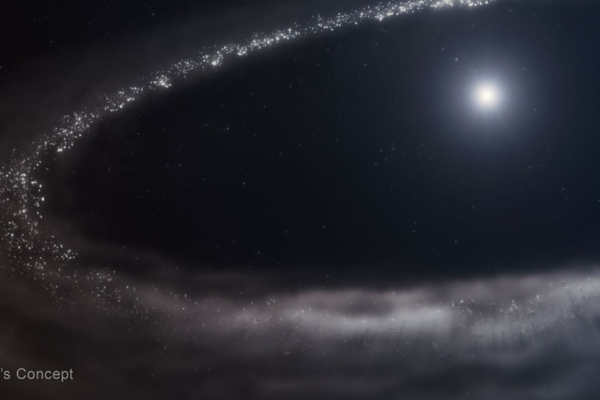For a long time, astronomers have been expecting frozen water to exist in systems around stars. Now, for the first time, they have confirmed the presence of crystalline water ice in the dust disk orbiting a young star, thanks to the James Webb Space Telescope of the National Aeronautics and Space Administration (NASA).
According to the press release issued by NASA on May 14th, the star named HD 181327, a sun-like star, is located 155 light years away from Earth. Astronomers have solid evidence of the existence of crystalline water ice in the dust disk orbiting this star through the spectrum obtained by the Webb Space Telescope.
The term “water ice” indicates that its composition is water, as astronomers have also observed many other frozen molecules in space, such as “dry ice,” which is carbon dioxide ice.
As early as 2008, data from NASA’s now-retired Spitzer Space Telescope hinted at the possibility of water ice existing in the system of HD 181327.
Researchers state that the Webb Space Telescope not only clearly detected water ice in the system but also confirmed it to be crystalline water ice. This type of water ice has also been found in frozen bodies in Saturn’s rings and the Kuiper Belt in the solar system.
One of the authors of the study, Christine Chen, an assistant astronomer at the Space Telescope Science Institute, mentioned that astronomers have been waiting for this precise data for decades. It was only with the Webb Space Telescope in operation that they had sensitive enough instruments to conduct such observations.
She said, “Most notably, these data are similar to other observations recently made by the telescope on objects in our solar system’s Kuiper Belt.”
Water ice is an important component of the disk-shaped structure around young stars – it has a significant impact on the formation of giant planets and may be transported to fully formed rocky planets through small bodies like comets and asteroids.
Compared to the 4.6-billion-year-old Sun, HD 181327 is considered relatively young, with an estimated age of only 23 million years. This star is slightly larger and hotter than the Sun, hence forming a slightly larger system around it.
Chen stated, “HD 181327 is a very dynamic system. Its disk has regular, ongoing collisions. When these freezing bodies collide, they release tiny dust-ice particles, the sizes of which are within the detection range of the Webb Space Telescope.”
Researchers note that the distribution of water ice in the system is not uniform, with most of it located in the coldest, farthest areas from the star. There is over 20% water ice in the outer regions of the disk, only about 8% in the central region, and the Webb Space Telescope hardly detected any water ice in the areas closest to the star.
This may be due to the star’s ultraviolet radiation causing the closest water ice to evaporate, or rocks called planetesimals “locking up” the internal water ice, making it undetectable by the Webb Space Telescope.
NASA stated that the discovery of this water ice opens doors for all researchers to study how these processes operate in many other planetary systems in new ways. Researchers will continue to search for and study water ice in debris disks throughout the galaxy and in actively forming planetary systems.
The results of this study were published in the journal “Nature” on May 14th.

